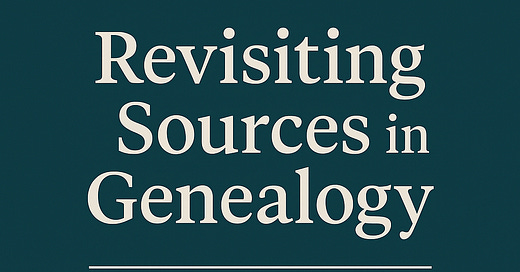Have you ever returned to a familiar source and found something new? It happens more often than we might admit. We consult a source, extract the relevant information for a specific person or family line, and move on. But sometimes, a second look reveals people or details we missed, or even contradictions worth resolving.
That’s exactly what happened to me during a review of older genealogy.
A Missed Generation in the Booth Family
While reviewing Donald Lines Jacobus’s 1952 genealogy of the Booth family of Connecticut, I noticed something curious. Jacobus, a widely respected genealogist, documented only two children: Josiah and Philo, for Lemuel and Mehetabel Booth. But when I revisited Massachusetts town records, I discovered six more children that Jacobus had not mentioned.
According to the Massachusetts Town Vital Collections, 1620–1988, on Ancestry.com, Lemuel and Mehetabel had:
* Anna, b. 9 July 1774
* Zechary, b. 21 October 1775
* Elisha, b. 16 November 1778
* Laura, b. 8 October 1784
* Sarah, b. 27 April 1787
* Eloisa, b. 5 December 1792
These records place the family in Lenox, Massachusetts, which Jacobus acknowledged but did not explore in detail. Why were these six children overlooked?
There are a few possibilities. Some of the children may have died before the first federal census in 1790. Jacobus may not have had access to Lenox town records or didn't prioritize that branch of the family. Still, these omissions highlight the importance of what genealogists now call reasonably exhaustive research.
Following Up Can Change the Picture
By following up on a brief mention in Jacobus’s book, that the Booths lived in Lenox, I was able to find records that reshaped my understanding of that family line. These discoveries didn’t just add names; they clarified relationships and extended the narrative.
Revisiting that source with a broader perspective led to finding exact birthdates, including for Philo Booth, one of the two children Jacobus did document. Interestingly, this created a new conflict: according to the 1850 U. S. Census, Philo was born in Connecticut. But the Lenox town records show a birth in Massachusetts.
So, which is it? The census record may reflect what Philo or someone close to him reported. The Lenox birth entry may have been recorded after the fact or even based on an assumption. Without more evidence, such as church records, land transactions, or probate files, the birthplace is still a puzzle. But it’s one I wouldn’t have known existed without rechecking the source.
Why This Matters for All of Us
If a genealogist as meticulous as Jacobus can miss data, the rest of us certainly can, too. New records are constantly being digitized. Databases improve, indexing errors get corrected, and sometimes our own research habits evolve.
That’s why I now make it a practice to revisit key sources every 5–10 years. It’s a great way to:
Catch details missed the first time
Clarify ambiguous relationships
Challenge long-held assumptions
Strengthen our documentation trail
Revisiting sources isn’t just about fixing mistakes. It’s about growing the story, filling in gaps, tying up loose ends, and giving future researchers a more complete picture.
Final Thoughts
As genealogists, we often focus on uncovering what’s new. But there’s real value in returning to what we’ve already seen. A second look may be the key to unlocking something hidden in plain sight.
So next time you're between new discoveries, pick an old source and give it another read. You might be surprised by what you find.
Sources Cited
* Donald Lines Jacobus, The Genealogy of the Booth Family: Booth Families of Connecticut for Six or More Generations (Pleasant Hill, Missouri: Eden C. Booth, 1952), page 84.
* “Massachusetts, Town and Vital Records, 1620–1988,” database with images, Ancestry.com.
* Lorraine Cook White, compiler, The Barbour Collection of Connecticut Town Vital Records – Sterling 1794–1850, Stratford 1639–1840 (Baltimore, Md.: Genealogical Publishing Company, 2000), pages 84–91.
* 1790 United States Federal Census.
* 1850 United States Federal Census.



